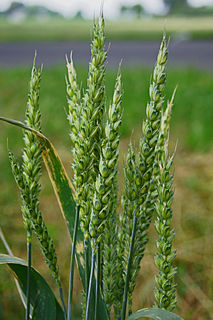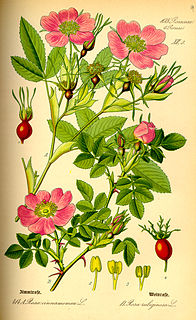
Arecales is an order of flowering plants. The order has been widely recognised only for the past few decades; until then, the accepted name for the order including these plants was Principes.

The Fabales are an order of flowering plants included in the rosid group of the eudicots in the Angiosperm Phylogeny Group II classification system. In the APG II circumscription, this order includes the families Fabaceae or legumes, Quillajaceae, Polygalaceae or milkworts, and Surianaceae. Under the Cronquist system and some other plant classification systems, the order Fabales contains only the family Fabaceae. In the classification system of Dahlgren the Fabales were in the superorder Fabiflorae with three families corresponding to the subfamilies of Fabaceae in APG II. The other families treated in the Fabales by the APG II classification were placed in separate orders by Cronquist, the Polygalaceae within its own order, the Polygalales, and the Quillajaceae and Surianaceae within the Rosales.

The Magnoliales are an order of flowering plants.

The Poales are a large order of flowering plants in the monocotyledons, and includes families of plants such as the grasses, bromeliads, and sedges. Sixteen plant families are currently recognized by botanists to be part of Poales.

Rosales is an order of flowering plants. It is sister to a clade consisting of Fagales and Cucurbitales. It contains about 7,700 species, distributed into about 260 genera. Rosales comprise nine families, the type family being the rose family, Rosaceae. The largest of these families are Rosaceae (90/2500) and Urticaceae (54/2600). The order Rosales is divided into three clades that have never been assigned a taxonomic rank. The basal clade consists of the family Rosaceae; another clade consists of four families, including Rhamnaceae; and the third clade consists of the four urticalean families.

The Solanales are an order of flowering plants, included in the asterid group of dicotyledons. Some older sources used the name Polemoniales for this order.

The Santalales are an order of flowering plants with a cosmopolitan distribution, but heavily concentrated in tropical and subtropical regions. It derives its name from its type genus Santalum (sandalwood). Mistletoe is the common name for a number of parasitic plants within the order.

The Dilleniales are an order of flowering plants, potentially containing one family, Dilleniaceae. The APG III system of 2009, like the earlier APG II system of 2003, left the Dilleniaceae unplaced as to order, while noting that the name Dilleniales was available. Stevens at the Angiosperm Phylogeny Website has subsequently placed Dilleniaceae in the order Dilleniales.

Nepenthales is an order of carnivorous flowering plants in the Cronquist system of plant classification.

Ranunculales is an order of flowering plants. Of necessity it contains the family Ranunculaceae, the buttercup family, because the name of the order is based on the name of a genus in that family. Ranunculales belongs to a paraphyletic group known as the basal eudicots. It is the most basal clade in this group; in other words, it is sister to the remaining eudicots. Widely known members include poppies, barberries, hellebores, and buttercups.

The Zygophyllales are an order of dicotyledonous plants, comprising the following two families:

Berberidopsidales is an order of Southern Hemisphere woody flowering plants. The name is newly accepted in the APG III system of plant taxonomy. APG II system, of 2003, mentions the possibility of recognizing the order, as comprising the families Berberidopsidaceae and Aextoxicaceae. However, APG II left the families unplaced as to order, assigning them to the clade core eudicots. The APG III system of 2009 formally recognized the order.

Asphodelaceae is a family of flowering plants in the order Asparagales. Such a family has been recognized by most taxonomists, but the circumscription has varied widely. In its current circumscription in the APG IV system, it includes about 40 genera and 900 known species. The type genus is Asphodelus.
A system of plant taxonomy, the Thorne system of plant classification was devised by the American botanist Robert F. Thorne (1920–2015) in 1968, and he continued to issue revisions over many years (1968–2007).
Plant taxonomy is the science that finds, identifies, describes, classifies, and names plants. It is one of the main branches of taxonomy.

The Thurniaceae are a family of flowering plants composed of two genera with four species. The botanical name has been recognized by most taxonomists.
One of the modern systems of plant taxonomy, the Dahlgren system was published by monocot specialist Rolf Dahlgren in 1975 and revised in 1977, and 1980. However, he is best known for his two treatises on monocotyledons in 1982 and revised in 1985. His wife Gertrud Dahlgren continued the work after his death.

In plant taxonomy, commelinids is a clade of flowering plants within the monocots, distinguished by having cell walls containing ferulic acid.

In biological classification, taxonomic rank is the relative level of a group of organisms in an ancestral or hereditary hierarchy. A common system consists of species, genus, family, order, class (clade), phylum, kingdom, domain. The study of taxonomy is also called cladistics.

Caryophyllales is a diverse and heterogeneous order of flowering plants that includes the cacti, carnations, amaranths, ice plants, beets, and many carnivorous plants. Many members are succulent, having fleshy stems or leaves. The betalain pigments are unique in plants of this order and occur in all its families with the exception of Caryophyllaceae and Molluginaceae.
















